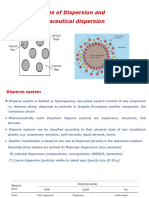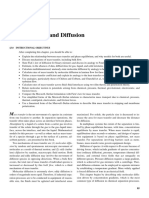Massachusetts Institute of Technology
Uploaded by
RunkitoMassachusetts Institute of Technology
Uploaded by
RunkitoMassachusetts Institute of Technology
Department of Materials Science and Engineering
77 Massachusetts Avenue, Cambridge MA 02139-4307
3.205 Thermodynamics and Kinetics of Materials—Fall 2006
December 5, 2006
Kinetics Lecture 11: Particle Coarsening
Lecture References
1. Porter and Easterling, Phase Transformations in Metals and Alloys, Van Nostrand Reinhold (Interna
tional), Wokingham, 1988. Section 5.5.6, pp. 314–317.
2. Balluffi, Allen, and Carter, Kinetics of Materials, Section 15.1, “Coarsening of a Distribution of
Particles,” pp. 363–373.
Key Concepts
• Capillarity (effects of excess surface free energy) provides the driving force for many important pro
cesses that lead to microstructural changes. The capillarity driving force is the change of free energy
when an interface sweeps through a unit volume of material. It is equal to γ(κ1 + κ2 ), where γ is
the excess surface free energy per unit area and κ1 and κ2 are the principal curvatures of the surface.
The sum (κ1 + κ2 ) is called the mean curvature of the surface and it varies from point to point on a
surface of arbitrary shape. For a sphere, the mean curvature is 2/R; for a cylinder, it is 1/R; for a
plane, it is zero.
• Particle coarsening occurs spontaneously in two-phase systems comprised of a distribution of parti
cle sizes, and it is driven by a reduction in the total interphase boundary energy, as small particles
continually dissolve and feed the growth of larger particles. A kinetic model for particle coarsening
starts with the Gibbs–Thomson equation which relates chemical potentials to particle size and results
in the following expression for the matrix solubility as a function of particle size for a dilute solution
(see KoM Fig. 15.1, p. 364):
� � � �
eq eq 2γΩ eq 2γΩ
c (R) = c (∞) exp ≈ c (∞) 1 + (1)
kT R kT R
A two-phase solution of very small particles in a matrix will have a higher solute content in the
matrix phase than a similar two-phase solution of larger particles. When a distribution of particle
sizes exists in a two-phase solution, and there is local equilibrium at the particle/matrix interfaces, the
concentration gradients that result in the matrix lead to solute diffusion from small particles to larger
ones.
• The kinetics of volume-diffusion controlled coarsening can be derived by considering the solute dif
fusion field in the matrix, and follow a “t-to-the-one-third” law for the mean particle size having the
form
� 2 ceq (∞)
8DγΩ
�R(t)�3 − �R(0)�3 = t = κ t (2)
9kT
You might also like
- Actom Hve Ctb36 Outdoor Circuit Breakers Aug 2018 LRNo ratings yetActom Hve Ctb36 Outdoor Circuit Breakers Aug 2018 LR6 pages
- Diffusiophoresis Migration of Colloidal Particles in Gradients of Solute ConcentrationNo ratings yetDiffusiophoresis Migration of Colloidal Particles in Gradients of Solute Concentration38 pages
- Reviews in Computational ChemistryFrom EverandReviews in Computational ChemistryAbby L. ParrillNo ratings yet
- Coupled CFD-DEM Modeling: Formulation, Implementation and Application to Multiphase FlowsFrom EverandCoupled CFD-DEM Modeling: Formulation, Implementation and Application to Multiphase FlowsNo ratings yet
- Activation Energy For Coarsening - SK BattacharyaNo ratings yetActivation Energy For Coarsening - SK Battacharya5 pages
- Electron Beam-Specimen Interactions and Simulation Methods in MicroscopyFrom EverandElectron Beam-Specimen Interactions and Simulation Methods in MicroscopyNo ratings yet
- Heterogeneous Catalysis at Nanoscale for Energy ApplicationsFrom EverandHeterogeneous Catalysis at Nanoscale for Energy ApplicationsNo ratings yet
- Mechanical Properties of Nanostructured Materials: Quantum Mechanics and Molecular Dynamics InsightsFrom EverandMechanical Properties of Nanostructured Materials: Quantum Mechanics and Molecular Dynamics InsightsNo ratings yet
- Infrared Spectroscopy of Diatomics for Space ObservationFrom EverandInfrared Spectroscopy of Diatomics for Space ObservationNo ratings yet
- Theories of Dispersion and Pharmaceutical DispersionNo ratings yetTheories of Dispersion and Pharmaceutical Dispersion15 pages
- Copper Zinc Tin Sulfide-Based Thin-Film Solar CellsFrom EverandCopper Zinc Tin Sulfide-Based Thin-Film Solar CellsKentaro ItoNo ratings yet
- lecture 5 PHASE TRANSFORMATIONS in Metal and AlloysNo ratings yetlecture 5 PHASE TRANSFORMATIONS in Metal and Alloys16 pages
- Theory and Applications of the Empirical Valence Bond Approach: From Physical Chemistry to Chemical BiologyFrom EverandTheory and Applications of the Empirical Valence Bond Approach: From Physical Chemistry to Chemical BiologyFernanda DuarteNo ratings yet
- Chapter 22 Precipitation and Crystallization KineticsNo ratings yetChapter 22 Precipitation and Crystallization Kinetics46 pages
- Method of Moments for 2D Scattering Problems: Basic Concepts and ApplicationsFrom EverandMethod of Moments for 2D Scattering Problems: Basic Concepts and ApplicationsNo ratings yet
- Reactive Oxygen Species: Signaling Between Hierarchical Levels in PlantsFrom EverandReactive Oxygen Species: Signaling Between Hierarchical Levels in PlantsFranz-Josef SchmittNo ratings yet
- Antimateria Biológica, Constante Cosmológica, y Mecánica Cuántica Relativista: Biological Antimatter, Cosmological Constant, and Relativistic Quantum MechanicsFrom EverandAntimateria Biológica, Constante Cosmológica, y Mecánica Cuántica Relativista: Biological Antimatter, Cosmological Constant, and Relativistic Quantum MechanicsNo ratings yet
- Self-Assembling Systems: Theory and SimulationFrom EverandSelf-Assembling Systems: Theory and SimulationLi-Tang YanNo ratings yet
- Nanometer-scale Defect Detection Using Polarized LightFrom EverandNanometer-scale Defect Detection Using Polarized LightNo ratings yet
- Diffusion Mass Transfer: Dr. Abdulbari AlboraniNo ratings yetDiffusion Mass Transfer: Dr. Abdulbari Alborani41 pages
- Rate Phenomena in Process Metallurgy - Szekely, Themelis (Chapter - 11)No ratings yetRate Phenomena in Process Metallurgy - Szekely, Themelis (Chapter - 11)36 pages
- Archaeometallurgy The Study of PreindustNo ratings yetArchaeometallurgy The Study of Preindust21 pages
- Isasmelt™ at Mufulira - Increased Flexibility On The Zambian CopperbeltNo ratings yetIsasmelt™ at Mufulira - Increased Flexibility On The Zambian Copperbelt10 pages
- Sulfur Solubility of Liquid and Solid Fe-Cr Alloys: A Thermodynamic AnalysisNo ratings yetSulfur Solubility of Liquid and Solid Fe-Cr Alloys: A Thermodynamic Analysis9 pages
- Massachusetts Institute of Technology: Number M S M S Number MNo ratings yetMassachusetts Institute of Technology: Number M S M S Number M5 pages
- Graduate Brochure 2017 Rev 7.zp120596 PDFNo ratings yetGraduate Brochure 2017 Rev 7.zp120596 PDF21 pages
- Control of A Grid-Tied Single-Phase Inverter For Renewable Energy IntegrationNo ratings yetControl of A Grid-Tied Single-Phase Inverter For Renewable Energy Integration75 pages
- Solar Thermal and Biomass Energy 1st Edition G. Lorenzini 2024 Scribd DownloadNo ratings yetSolar Thermal and Biomass Energy 1st Edition G. Lorenzini 2024 Scribd Download51 pages
- 35538fuel Cells GCM Lecture Note For 6th Sem 18 04 2020No ratings yet35538fuel Cells GCM Lecture Note For 6th Sem 18 04 202017 pages
- Poll No Syllabus Poll No Syllabus Poll No Syllabus Poll No Syllabus Botany Zoology Test Date Test Numb Er Physics ChemistryNo ratings yetPoll No Syllabus Poll No Syllabus Poll No Syllabus Poll No Syllabus Botany Zoology Test Date Test Numb Er Physics Chemistry2 pages
- Solar Based Auto Irrigation System: Guided By: Prof. Rakesh B. VasaniNo ratings yetSolar Based Auto Irrigation System: Guided By: Prof. Rakesh B. Vasani18 pages
- Technical & Commercial Proposal Preparation of Design Report Naltar-III HEPP100% (1)Technical & Commercial Proposal Preparation of Design Report Naltar-III HEPP2 pages
- Technical Note - 2019 Metal Vs Graphite Bipolar Plates UpdateNo ratings yetTechnical Note - 2019 Metal Vs Graphite Bipolar Plates Update2 pages
- Immediate download ENERGY 2040: Aligning Innovation, Economics and Decarbonization 1st Edition Divan ebooks 2024100% (1)Immediate download ENERGY 2040: Aligning Innovation, Economics and Decarbonization 1st Edition Divan ebooks 202465 pages
- Low Cost Pure Sine Wave Solar Inverter CircuitNo ratings yetLow Cost Pure Sine Wave Solar Inverter Circuit15 pages
- 200 TOP Steam Boilers, Engines, Nozzles and Turbines - Mechanical Engineering Multiple Choice Questions and Answers List - MCQs Preparation For Engineering Competitive Exams100% (1)200 TOP Steam Boilers, Engines, Nozzles and Turbines - Mechanical Engineering Multiple Choice Questions and Answers List - MCQs Preparation For Engineering Competitive Exams32 pages





































































































